Table 1 shows the summary statistics for establishments with ATE of 20 and over for the total Philippines and by sector based on the preliminary results of the 2006 CPBI. Comparative data from the 1999 CPBI and the 2001 Annual Survey of Philippine Business and Industry (ASPBI), 2003 ASPBI and 2005 ASPBI are also presented.
Manufacturing sector dominates the economy
In 2006, the Philippines had a total of 21,217 establishments with ATE of 20 and over, a drop of 19.7 percent from the 26,407 establishments recorded in 2005. By sector, as shown in Figure 1, the Manufacturing sector comprised about one-fourth (23.7%) of the total number of establishments with ATE of 20 and over. The Wholesale and retail trade sector with a share of 21.4 percent, ranked second and the Hotels and restaurants sector with 13.0 percent was a far third. On the other hand, the Mining and quarrying sector recorded the lowest number of establishments. The rank of these sectors remained the same compared to those in 2005.
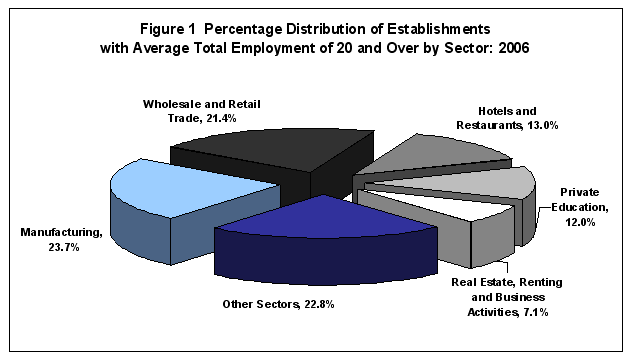
Manufacturing sector generates the highest employment
Employment in 2006 of establishments with ATE 20 and over, reached a total of 2,631,889, a decline of 4.0 percent from the 2,741,292 in 2005. Compared to 2005, the 14 sectors were equally divided. Half registered increases in employment and the other half, decreases. Construction, Agriculture, hunting and forestry, Real estate, renting and other business activities, Financial intermediation, Health and social work, Private education, and Mining and quarrying sectors increased employment. Sectors with declining employment were: Wholesale and retail trade, Other community, social and personal services, Hotels and restaurants, Transport, storage and communications, Fishing, Manufacturing, and Electricity, gas and water supply.
In 2006, the Manufacturing sector ranked first, engaging more than one-third (37.0%) of the total employment. The Real estate, renting and business activities sector, despite placing fifth in terms of number of establishments, garnered the second place with 13.6 percent, followed by the Wholesale and retail trade with 8.7 percent. The Mining and quarrying sector employed the least number of employees (10,300).
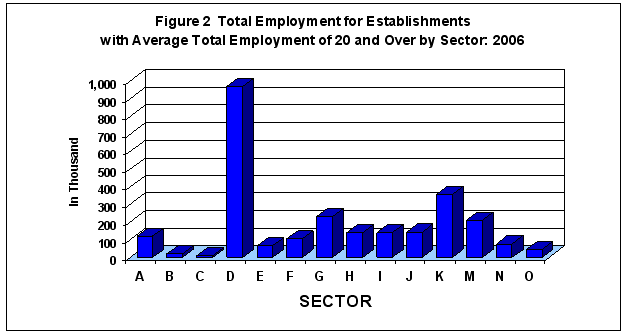
Employees of Manufacturing sector receives the highest total compensation
The total national compensation for all sectors in 2006 amounted to 511.1 billion pesos, an increase of 6.5 percent compared to 2005 with 479.9 billion pesos. Among sectors, top payer of compensation was Manufacturing with 169.4 billion pesos, comprising one-third of the total compensation. Real estate and other business activities sector was a far second (13.2%), paying 67.4 billion pesos, followed closely by Financial intermediation sector with 66.4 billion pesos (13.0%). The Fishing sector expended the least compensation at 1.8 million pesos.
Compared to 2005, compensation of Real estate and other business activities increased the most with 32.6%, followed by Construction (21.2%) and Agriculture (19.8%).
Manufacturing sector top revenue producer
Economy-wide, total revenue or total sales earned in 2006 reached 6.4 trillion pesos, an increase of 3.3 percent from 6.2 trillion pesos in 2005. Almost half (49.6%) of the total revenue was contributed by the Manufacturing sector, the top revenue producer, with 3.2 trillion pesos. In second place was the Wholesale and retail trade sector earning 865.1 billion pesos (13.6%) followed by Financial intermediation with 644.1 billion pesos (10.1%). The Fishing sector generated the least revenue among sectors with 10.8 billion pesos.
Compared to 2005, the ranking of the top revenue producers was the same. However, it is noted that while the total revenue for the Financial intermediation and Manufacturing increased by 16.2 percent and 7.0 percent, respectively, that for the Wholesale and retail trade decreased by 14.5 percent. Other sectors with increases in revenues were Agriculture, hunting and forestry (33.0%), Construction (20.8%), Financial intermediation (16.2%) and Electricity, gas and water (7.6%). Aside from the Wholesale and retail trade, four other sectors recorded decreased revenues, namely: Mining and quarrying (40.3%), Other Community, social and personal service activities (16.4%), Hotels and restaurants (9.1%), and Transport, storage and communications (0.9%).
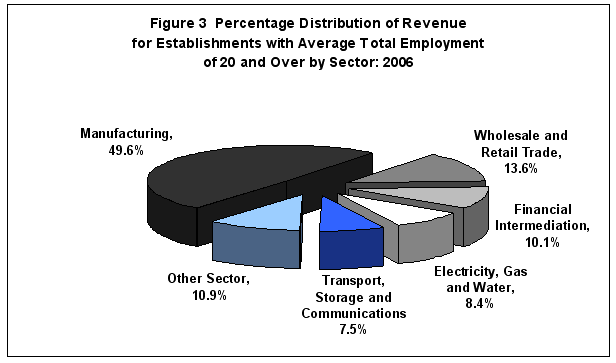
Total cost reaches PhP4.8 trillion, Manufacturing sector spends the largest
Economy-wide, total cost amounted to 4.8 trillion pesos. The Manufacturing sector, the highest with 2.5 trillion pesos, incurred more than half (51.7%) of the total cost. The Wholesale and retail trade sector ranked second with 795.4 billion pesos followed by the Financial intermediation with 404.0 billion pesos. Top three spenders in 2005 were Manufacturing (PhP2.434 trillion), Wholesale and retail trade (PhP934.5B) and Electricity, gas and water supply (PhP378.3B). The Fishing sector spent the least with 8.8 billion pesos in 2006 as in 2005 (PhP7.4B).
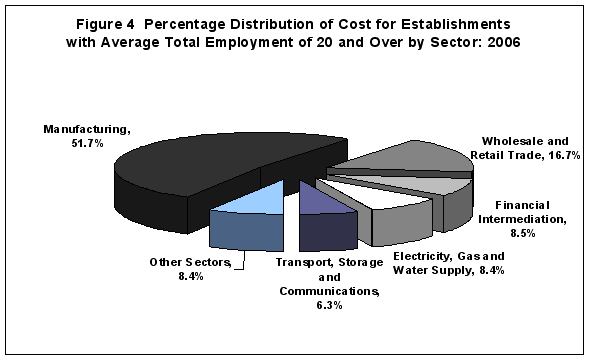
Value added amounts to P2.1 trillion, Highest value added in Manufacturing
Value added, the indicator which measures the value of the output minus the intermediate inputs, was estimated at 2.1 trillion pesos in 2006 for all sectors, an increase of 12.0 percent from the 1.9 trillion pesos in 2005. Top three sectors in terms of value added were Manufacturing (PhP868.1B), Financial intermediation (PhP310.9B) and Transport, storage and communications (PhP292.1B). While the value added of Manufacturing increased by 26.8 percent, that of Mining and quarrying declined by 57.2 percent.
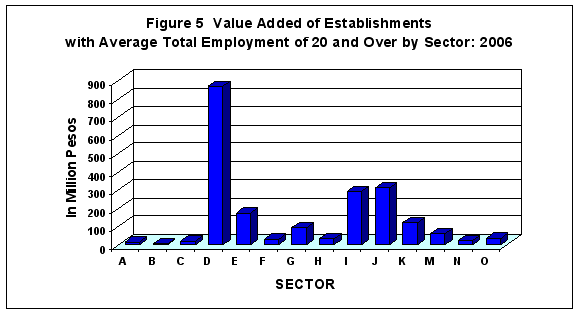
Table 2 presents some selected indicators for establishments with ATE of 20 and over for the total Philippines and by sector. These are average annual compensation, revenue per employment and value added per total employment. Comparative indicators for 2006 as well as those for 1999, 2001, 2003 and 2005 are also shown.
Financial intermediation employees earn highest average annual compensation
Average annual compensation indicates the total compensation per paid employee. The Philippines had an average annual compensation of 195,342 pesos in 2006, an increase of 11.0 percent from 176,057 pesos in 2005.
In terms of average annual compensation, Financial intermediation employees with 468,271 pesos topped all sectors. Transport, storage and communications employees ranked second with 341,332 pesos, closely followed by Electricity, gas and water supply employees with 327,473 pesos. Fishing sector employees were the least paid receiving only an average annual compensation of 95 thousand pesos, even lower by 8.7 from 103,821 pesos in 2005.
Except for the Fishing sector, all sectors registered increases in the average annual compensation in 2006 compared to those in 2005, with the Wholesale and retail trade leading at 23.0 percent. Transport, storage and communications and Real Estate and other business activities at 20.7 percent and 20.1 percent, respectively, registered almost similar increases.
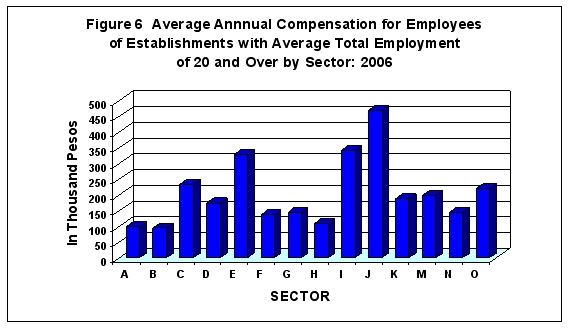
Employees of Electricity, gas and water supply most productive in 2006
Labor productivity may be measured in several ways. Revenue per employment is one method. This indicator is computed by dividing the Total Revenue or Total Sales by the Total Employment. Using this measure of labor productivity, the Electricity, gas and water supply sector was the most productive in 2006 with 8.5 million pesos surpassing the national average of 2.4 million pesos. Financial intermediation followed next with 4.5 million pesos. Sectors with labor productivity ranging from 3.2 to 3.8 million pesos were the Wholesale and retail trade (PhP3.8M), Mining and quarrying (PhP3.5M), Transport, storage and communications (PhP3.4M) and Manufacturing (PhP3.2M). Comparing the 2006 with the 2005 indicators, except for Mining and quarrying and Real estate and other business activities, all sectors registered increases in revenue per employment.
Private Education, on the other hand, recorded the least revenue per employment in both years with only 403 thousand pesos in 2006 and 363 thousand pesos in 2005.
Another measure of labor productivity is Value Added per Total Employment. Adopting this measure, labor productivity at the national level in 2006, was valued at PhP787,964, an increase of 16.6 percent from P675,596 estimated in 2005. Top three sectors for this indicator in 2006 were: Electricity, gas and water supply (PhP2.8M), Financial intermediation (PhP2.2M) and Transport, storage and communications (PhP2.1M). Comparing the performance in 2006 with that of 2005, Mining and quarrying which ranked first in 2005, ranked fourth only in 2006. The top three sectors in 2006, ranked second, third and fourth, respectively, in 2005.
Agriculture, hunting and forestry had the lowest value added per employment in both years, with PhP130,187 and PhP126,764, respectively.
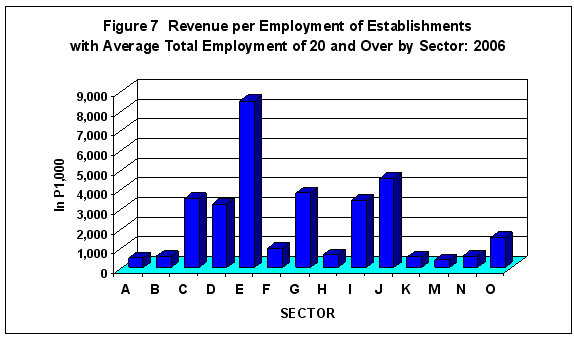
TECHNICAL NOTES
Introduction
An economic census is a comprehensive collection, compilation, evaluation, analysis and publication of data about the economic activities of the country. It is a source of information for establishing a benchmark level for the measurement and comparison of national, regional and provincial economic growth. Particularly, the economic census data will be used in constructing national and regional income accounts in the country, in determining and comparing regional economic structures, in formulating plans and policies of the government in the attainment of economic goals, in providing updates for the frame of establishments and in the conduct of market research and feasibility studies.
The 2006 Census of Philippine Business and Industry (CPBI) is one of the designated statistical activities undertaken by the National Statistics Office. The 2006 CPBI is the 14th in the series of economic censuses conducted in the Philippines. It is preceded by those for 2000, 1994, 1988, 1983, 1978, 1975, 1972, 1967, 1961, 1948, 1939, 1918 and 1903. The present name, Census of Philippine Business and Industry was first used in the 2000 round with 1999 as the reference period.
Legal Authority
The conduct of the 2006 CPBI was governed by authority of the following legislative acts and presidential directives, namely:
- Commonwealth Act No. 591 (An Act to Create a Bureau of the Census and statistics, to Consolidate Statistical Activities of the Government Therein) approved on August 19, 1940. CA No. 591 empowers the Bureau, among other things, to prepare for and undertake all censuses of population, griculture, industry and commerce. The same act also provides penalty for persons who fail to accomplish Census forms.
- Presidential Decree No. 418 dated March 20, 1974 Reconstituting the Bureau of Census and Statistics to be known as the National Census and Statistics Office under the administrative supervision of the National Economic and Development Authority.
- Executive Order No. 121 Reorganization Act of the Philippine Statistical System, dated August 4, 1987 renaming the NCSO to the National Statistics Office which shall be the major statistical agency responsible for generating general purpose statistics
- Executive Order No. 352 - Designation of Statistical Activities that will generate critical data for decision-making of the Government and Private Sector signed on July 1, 1996.
- Executive Order No. 5 dated July 29, 1998, Strengthening the National Statistics Office.
Scope and Coverage
The 2006 CPBI covered establishments engaged in 14 economic sectors classified under the amended 1994 Philippine Standard Industrial Classification (PSIC) namely:
- A - Agriculture, Hunting and Forestry
- B - Fishing
- C - Mining and Quarrying
- D - Manufacturing
- E - Electricity, Gas and Water Supply
- F - Construction
- G - Wholesale and Retail Trade, Repair and Maintenance of Motor Vehicles, Motorcycles, and Personal and Household Goods
- H - Hotels and Restaurants
- I - Transportation, Storage and Communications
- J - Financial Intermediation
- K - Real Estate, Renting and Business Activities
- M - Private Education
- N - Health and Social Work
- O - Other Community, Social and Personal Service Activities
The following major divisions are excluded from the scope of the survey: L (Public Administration and Defense; Compulsory Social Security), P (Private Households with Employed Persons) and Q (Extra-Territorial Organization and Bodies).
The scope of the 2006 CPBI was confined to the "formal sector" only consisting of the following:
- Corporations and partnership
- Cooperatives and foundations
- Single proprietorships with employment of 10 or more
- Single proprietorships with branches
Unit of Enumeration
Like all other establishment surveys conducted by the NSO, the 2006 CPBI used establishment as the unit of enumeration. It is defined as an economic unit under a single ownership or control, i.e. under a single legal entity, engaged in one or predominantly one kind of economic activity at a single fixed location. In actual practice, however, there are difficulties in applying the definition of an establishment. Thus, it is defined in operational terms to take into account the organization and record-keeping practices of establishments by making the single location and activity criteria more flexible. This necessitates the use of the kind-of-activity unit for certain sectors as the single location restriction is eliminated.
For Construction, Transportation, storage and communications, Insurance, Real estate buying, developing, subdividing and selling, and Investigation and security activities, the establishment is defined in operational terms as the unit that is engaged in the production of the most homogeneous group of goods and services, usually at one location, but sometimes over a wider area, for which separate records are available that can provide data concerning production of these goods and services and the materials, labor and physical resources used in this production.
Classification of Establishments
Before the actual selection of samples, the establishments listed in the frame were classified based on economic organization (EO), legal organization (LO), industrial classification, employment size, and geographic location.
Economic organization refers to the organizational structure or role of the establishment in the organization. The following are the types of economic organization:
- Single establishment is an establishment which has neither branch nor main office
- Branch only is an establishment which has a separate main office located elsewhere
- Establishment and main office, both located in the same address and with branches elsewhere
- Main office only is the unit which controls, supervises and directs one or more establishments of an enterprise
- Ancillary unit other than main office is the unit that operates primarily or exclusively for a related establishment or group of related establishments or its parent establishment and provide goods or services that support but do not become part of the output of those establishments
The legal organization provides the legal basis for ownership of the establishment. The following are the types of legal organization:
- Single Proprietorship refers to a business establishment organized, owned, and managed by one person, who alone assumes the risk of the business enterprise. The establishment name is that of a person, or it has words such as Owner, Proprietor or Operator.
- Partnership refers to an association of two or more individuals for the conduct of a business enterprise based upon an agreement or contract between or among them to contribute money, property or industry into a common fund with the intention of dividing profits among themselves. The establishment name includes words such as Owners, Partners, Limited or LTD., Associates or ASSOCS.
- Government Corporation is a private corporation organized for private aim, benefit or purpose and owned and controlled by the government. The establishment name included words such as Corporation or CORP., INCORPORATED or INC.
- Private Corporation is a corporation organized by private persons. The establishment name includes words such Corporation or Corp, Incorporated or INC.
- Cooperative, the establishment name includes words such as Cooperative or COOP
The industrial classification of an economic unit is determined by the activity from which it derives its major income or revenue. The amended 1994 PSIC is utilized to classify units according to their economic activities.
The amended 1994 PSIC consists of an alpha character and 5 numeric digits. The alpha character, which represents the major division, is denoted by the characters A to Q. The first two numeric digits represent the division; the first three numeric digits, the group; the first four digits, the class; and the 5 digits, the sub-class.
The size of the establishment is determined by its average total employment (ATE). The following are the employment size classification used in the 2006 CPBI:
ATE | Average Total Employment |
| |
0 | 1-4 |
1 | 5-9 |
2 | 10-19 |
3 | 20-49 |
4 | 50-99 |
5 | 100-199 |
6 | 200-499 |
7 | 500-999 |
8 | 1000-1999 |
9 | 2000 and over |
The geographic or physical location of the establishments was classified in accordance with the Philippine Standard Geographic Code (PSGC) as of December 30, 2006 which contains the latest updates on the number of regions, provinces, cities, municipalities and barangays in the Philippines.
The geographic domains of the 2006 CPBI for establishments with average total employment (ATE) of 20 and over are the provinces, independent component cities, chartered cities and highly urbanized cities and municipalities. On the other hand, the geographic domains for establishments with ATE of less than 20 are the regions.
Hence, the samples of the 2006 CPBI with ATE 20 and over shall provide data for 17 administrative regions, 81 provinces, 39 cities and municipalities. For samples with ATE less than 20, the data that will be presented up to the regional level only.
Frame
The 2006 List of Establishments (LE) was used as the frame for the 2006 CPBI. The 2006 LE was based on the combined results of the following:
- 2004 ULE conducted in NCR and selected urban barangays
- 2005 ULE in rural barangays in provincial capitals/cities/municipalities
- Supplemental lists from other sources
Sampling Design
The 2006 CPBI used stratified systematic sampling with a random start. For establishments with ATE 20 and over, the geographic domain (provinces, independent component cities, chartered cities and highly urbanized cities and municipalities) and the industry domain (5-digit or group of 5-digit PSIC and/or 4-digit or group of 4-digit PSIC) served as the first stratification variable. On the other hand, for establishments with ATE less than 20, the geographic domains are the regions and the industry domain, the industry groups. Employment size (ATE) was used as the second stratification variable.
Sample Size
The sample size of the 2006 CPBI was 57,404 establishments broken down by ATE of 20 and over (26,448) and ATE of less than 20 (30,956).
Response Rate
The overall response rate for ATE of 20 and over is 93.4 percent or 22,389 out of 23,960. These include receipts of good questionnaires, partially accomplished questionnaires, reports of closed, moved out or out of scope establishments. However, the effective response rate is 83.5 percent.
Concepts and Definitions
Economic activity or business is the activity of the establishment as classified under the amended 1994 Philippine Standard Industrial Classification (PSIC). Generally, the main activity of the establishment is the establishment's principal source of income. If the establishment is engaged in several activities, its main activity is that which earns the biggest income or revenue.
Employment is the number of persons who worked in or for this establishment as of November 15, 2006.
Average total employment is the sum of the number of persons who worked in or for this establishment for all months of the year divided by 12, regardless of the number of months the establishment is in operation. is in operation.
Paid employees are all persons working in the establishment and receiving pay, as well as those working away from the establishment paid by and under the control of the establishment. Included are all employees on sick leave, paid vacation or holiday. Excluded are consultants, home workers, workers receiving pure commissions only, and workers on indefinite leave.
Salaries and wages are payments in cash or in kind to all employees, prior to deductions for employee's contributions to SSS/GSIS, withholding tax, etc. Included are total basic pay, overtime pay, and other benefits.
Value of output represents the sum of the total value of products sold, receipts from contract work and industrial services done for others, receipts from goods sold in the same condition as purchased less cost of goods sold, fixed assets produced on own account, and change in inventories of finished products and work-in-progress (ending less beginning). In the past surveys/censuses, estimation of value of output was not net of cost of goods sold but included change in inventory (ending less beginning) of goods for resale.
Cost of materials, fuels and electricity consumed and industrial services refers to expenses incurred in the production of goods and industrial services such as materials and supplies purchased, fuels purchased, electricity purchased and industrial services done by others and change in inventory of materials, supplies and fuels (beginning less ending). In the past surveys/censuses, cost of materials, fuels and electricity consumed and industrial services also include goods purchased for resale.
Census value added represents the difference between the value of output and total cost of materials, fuels and electricity consumed and industrial services.
Value added represents the sum of census value added and value of non-industrial services done for others less the cost of non-industrial services done by others and other costs.
Revenue is the value of goods, products/by-products sold and/or services rendered to others whether paid in cash or is considered receivable by the establishment. Valuation of products/by products sold should be in producers price (ex-establishment), net of discounts and allowances, including duties and charges but excluding subsidies. It also include goods transferred and/or services rendered to other establishment belonging to the same enterprise as the said establishment which should be treated as sales or as if sold to a customer; and revenue from products on a contractual basis from materials supplied by the establishment.
Cost refers to all expenses incurred during the year whether paid or payable. Valuation should be at market price including taxes and other charges, net of discounts, rebates, returns and allowances. Goods received from and services rendered by other establishment of the same enterprise are valued as though purchased.
Fixed assets are physical assets expected to have productive life of more than one year and intended for use and/or being used by the establishment. Included are land, buildings, other structures and land improvements, transport equipment, fixtures, machinery, tool, furniture, office equipment and other fixed assets.
Gross addition to fixed assets is the sum of costs of new and used fixed assets acquired during the year, cost of alteration and improvements done by others and cost of fixed assets produced by the establishment less the value of sales of fixed assets during the year.
Book value is the initial value or acquisition cost of fixed assets less the accumulated depreciation.
Inventories refer to the stocks of goods owned by and under the control of the establishment as of a fixed date, regardless of where the stocks are located. Valuation should be at current replacement cost in purchasers price at the indicated dates. Replacement cost is the cost of an item in terms of its present price rather than its original price.
Change in Inventories is equivalent to the total value of inventories at the end of the year less the value at the beginning of the year.
Subsidies are special grants in the form of financial assistance or tax exemption or tax privilege given by the government to aid and develop an industry or production and to protect it against competition.
Source: National Statistics Office
Manila, Philippines
